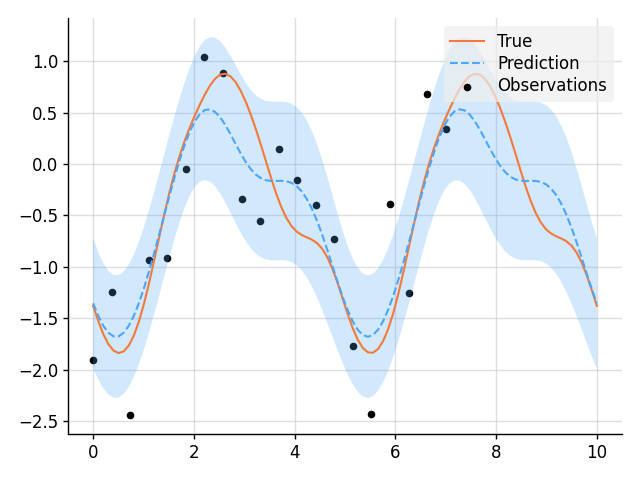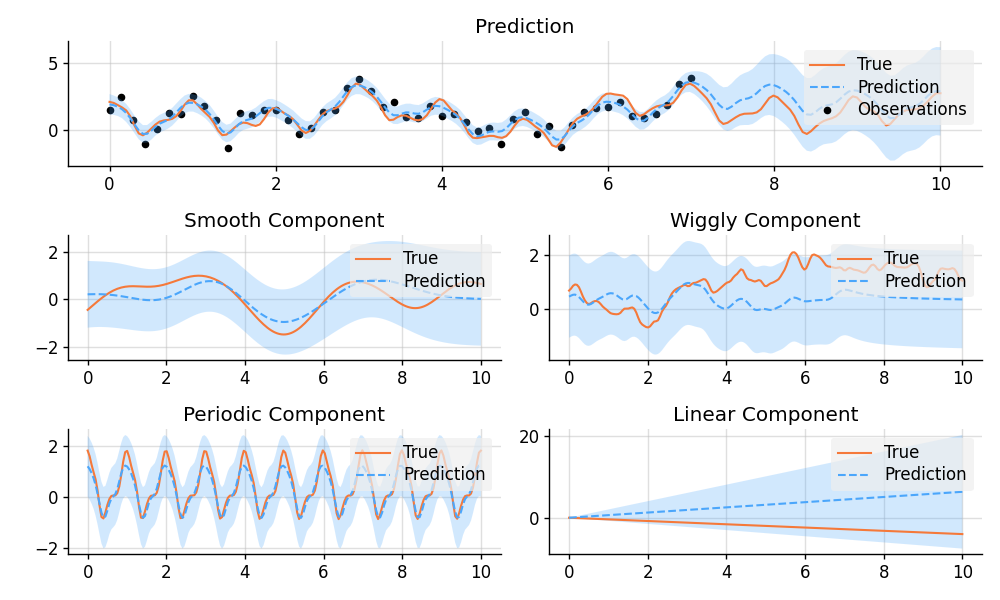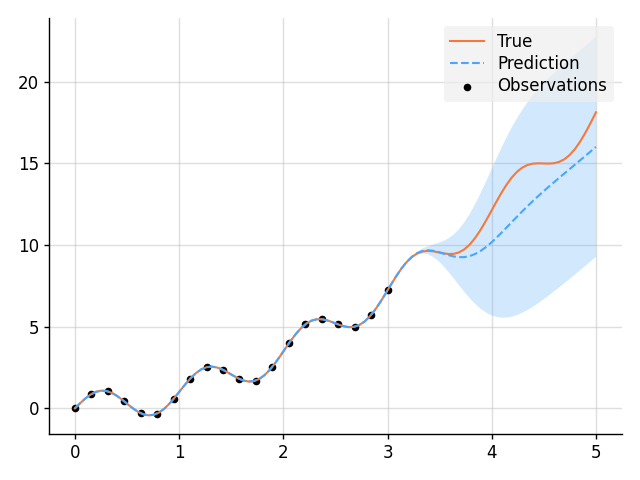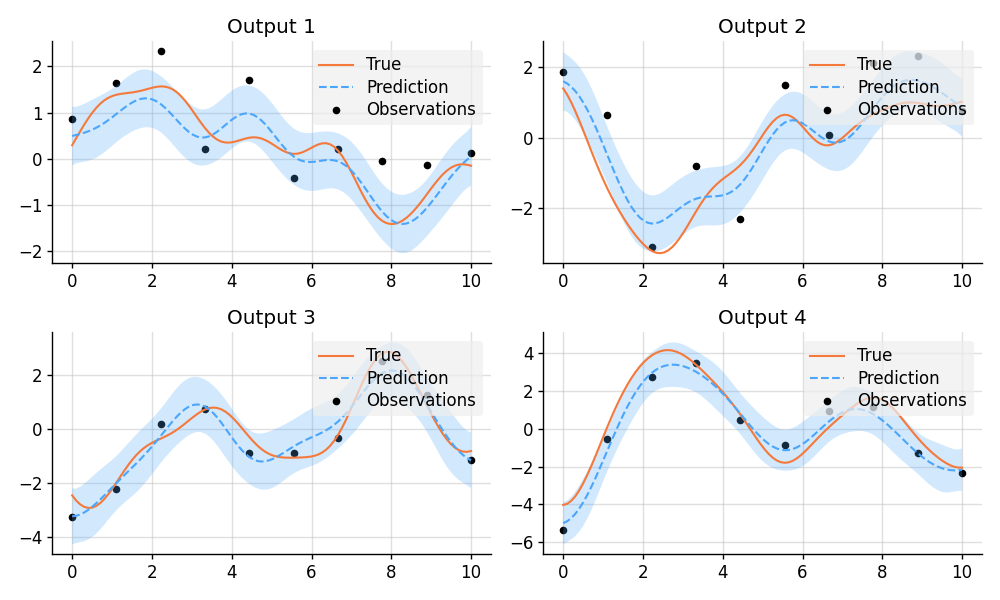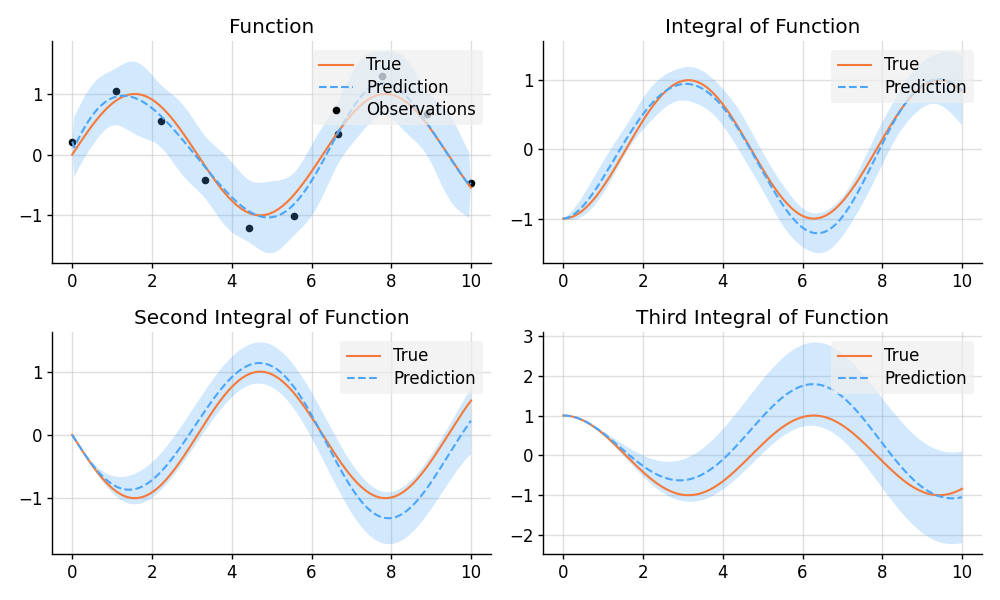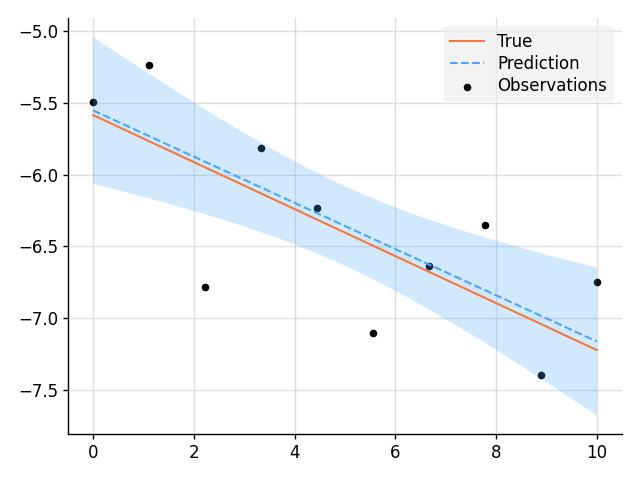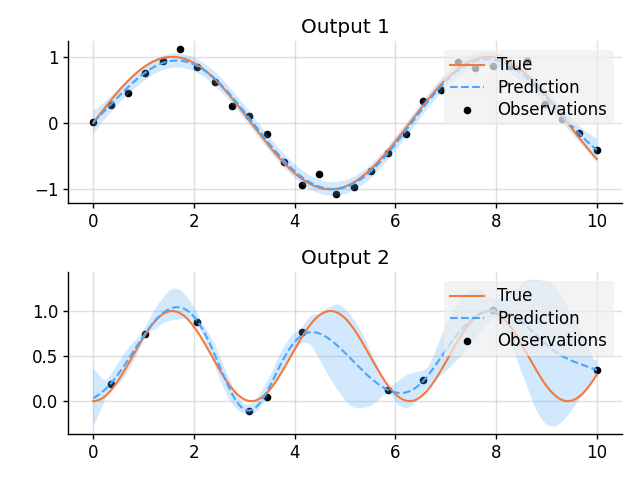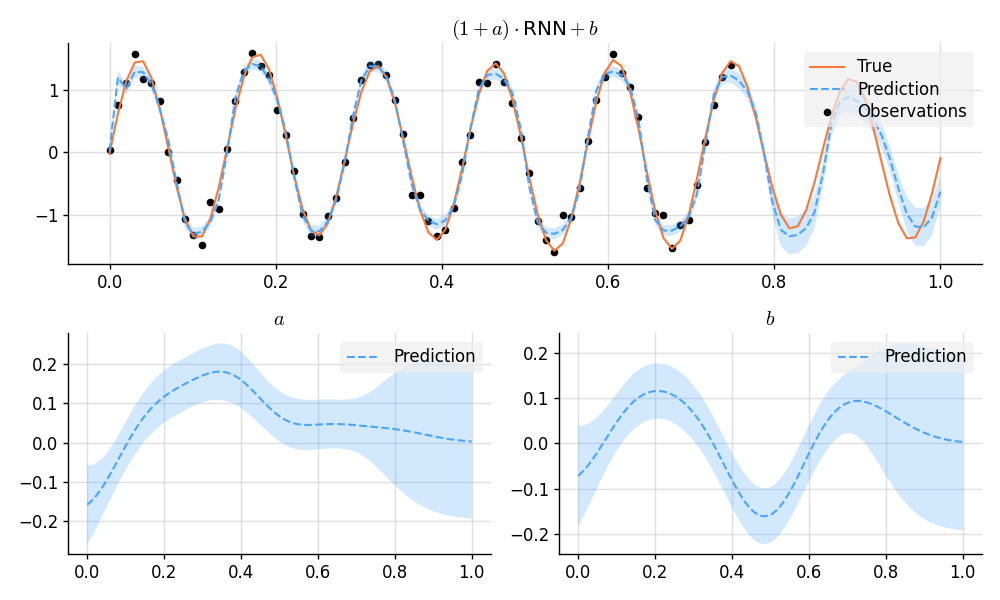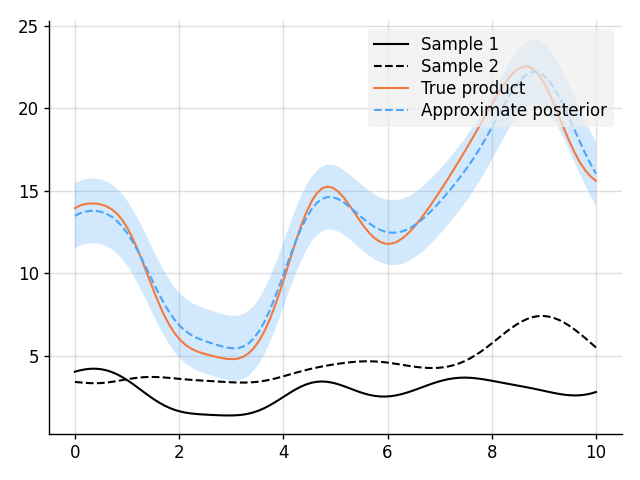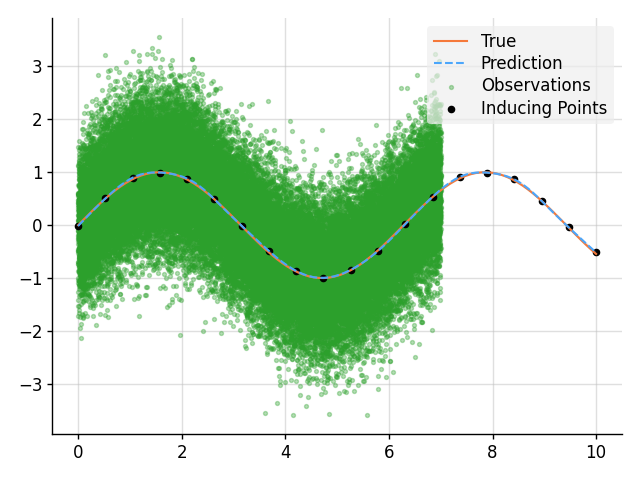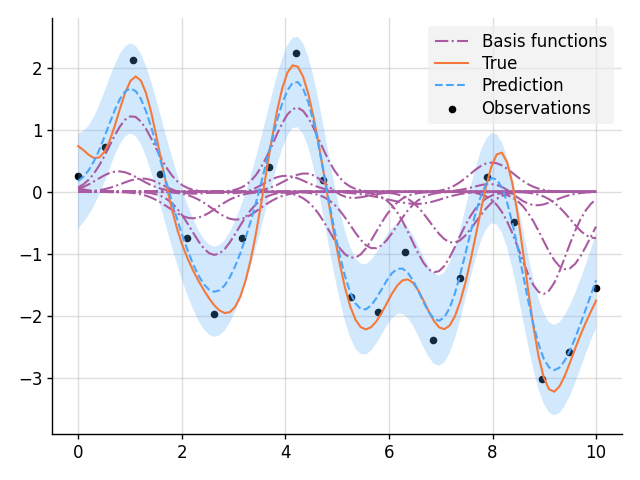wesselb / Stheno
Programming Languages
Projects that are alternatives of or similar to Stheno
Stheno
Stheno is an implementation of Gaussian process modelling in Python. See also Stheno.jl.
- Nonlinear Regression in 20 Seconds
- Installation
- Manual
-
Examples
- Simple Regression
- Decomposition of Prediction
- Learn a Function, Incorporating Prior Knowledge About Its Form
- Multi-Output Regression
- Approximate Integration
- Bayesian Linear Regression
- GPAR
- A GP-RNN Model
- Approximate Multiplication Between GPs
- Sparse Regression
- Smoothing with Nonparametric Basis Functions
Nonlinear Regression in 20 Seconds
>>> import numpy as np
>>> from stheno import Measure, GP, EQ
>>> x = np.linspace(0, 2, 10) # Some points to predict at
>>> y = x ** 2 # Some observations
>>> prior = Measure() # Construct a prior.
>>> f = GP(EQ(), measure=prior) # Define our probabilistic model.
>>> post = prior | (f(x), y) # Compute the posterior distribution.
>>> post(f).mean(np.array([1, 2, 3])) # Predict!
<dense matrix: shape=3x1, dtype=float64
mat=[[1. ]
[4. ]
[8.483]]>
Moar?! Then read on!
Installation
See the instructions here. Then simply
pip install stheno
Manual
Note: here is a nicely rendered and more readable version of the docs.
AutoGrad, TensorFlow, PyTorch, or Jax? Your Choice!
from stheno.autograd import GP, EQ
from stheno.tensorflow import GP, EQ
from stheno.torch import GP, EQ
from stheno.jax import GP, EQ
Important Remarks
Stheno uses LAB to provide an implementation that is backend agnostic. Moreover, Stheno uses an extension of LAB to accelerate linear algebra with structured linear algebra primitives. You will encounter these primitives:
>>> k = 2 * Delta()
>>> x = np.linspace(0, 5, 10)
>>> k(x)
<diagonal matrix: shape=10x10, dtype=float64
diag=[2. 2. 2. 2. 2. 2. 2. 2. 2. 2.]>
If you're using LAB to further process these matrices, then there is absolutely no need to worry: these structured matrix types know how to add, multiply, and do other linear algebra operations.
>>> import lab as B
>>> B.matmul(k(x), k(x))
<diagonal matrix: shape=10x10, dtype=float64
diag=[4. 4. 4. 4. 4. 4. 4. 4. 4. 4.]>
If you're not using LAB, you can convert these
structured primitives to regular NumPy/TensorFlow/PyTorch/Jax arrays by calling
B.dense (B is from LAB):
>>> import lab as B
>>> B.dense(k(x))
array([[2., 0., 0., 0., 0., 0., 0., 0., 0., 0.],
[0., 2., 0., 0., 0., 0., 0., 0., 0., 0.],
[0., 0., 2., 0., 0., 0., 0., 0., 0., 0.],
[0., 0., 0., 2., 0., 0., 0., 0., 0., 0.],
[0., 0., 0., 0., 2., 0., 0., 0., 0., 0.],
[0., 0., 0., 0., 0., 2., 0., 0., 0., 0.],
[0., 0., 0., 0., 0., 0., 2., 0., 0., 0.],
[0., 0., 0., 0., 0., 0., 0., 2., 0., 0.],
[0., 0., 0., 0., 0., 0., 0., 0., 2., 0.],
[0., 0., 0., 0., 0., 0., 0., 0., 0., 2.]])
Furthermore, before computing a Cholesky decomposition, Stheno always adds a minuscule
diagonal to prevent the Cholesky decomposition from failing due to positive
indefiniteness caused by numerical noise.
You can change the magnitude of this diagonal by changing B.epsilon:
>>> import lab as B
>>> B.epsilon = 1e-12 # Default regularisation
>>> B.epsilon = 1e-8 # Strong regularisation
Model Design
The basic building block is a f = GP(mean=0, kernel, measure=prior), which takes
in a mean, a kernel, and a measure.
The mean and kernel of a GP can be extracted with f.mean and f.kernel.
The measure should be thought of as a big joint distribution that assigns a mean and
a kernel to every variable f.
A measure can be created with prior = Measure().
A GP f can have different means and kernels under different measures.
For example, under some prior measure, f can have an EQ() kernel; but, under some
posterior measure, f has a kernel that is determined by the posterior distribution
of a GP.
We will see later how posterior measures can be constructed.
The measure with which a f = GP(kernel, measure=prior) is constructed can be
extracted with f.measure == prior.
If the keyword argument measure is not set, then automatically a new measure is
created, which afterwards can be extracted with f.measure.
Definition, where prior = Measure():
f = GP(kernel)
f = GP(mean, kernel)
f = GP(kernel, measure=prior)
f = GP(mean, kernel, measure=prior)
GPs that are associated to the same measure can be combined into new GPs, which is the primary mechanism used to build cool models.
Here's an example model:
>>> prior = Measure()
>>> f1 = GP(lambda x: x ** 2, EQ(), measure=prior)
>>> f1
GP(<lambda>, EQ())
>>> f2 = GP(Linear(), measure=prior)
>>> f2
GP(0, Linear())
>>> f_sum = f1 + f2
>>> f_sum
GP(<lambda>, EQ() + Linear())
>>> f_sum + GP(EQ()) # Not valid: `GP(EQ())` belongs to a new measure!
AssertionError: Processes GP(<lambda>, EQ() + Linear()) and GP(0, EQ()) are associated to different measures.
Compositional Design
-
Add and subtract GPs and other objects.
Example:
>>> GP(EQ(), measure=prior) + GP(Exp(), measure=prior) GP(0, EQ() + Exp()) >>> GP(EQ(), measure=prior) + GP(EQ(), measure=prior) GP(0, 2 * EQ()) >>> GP(EQ()) + 1 GP(1, EQ()) >>> GP(EQ()) + 0 GP(0, EQ()) >>> GP(EQ()) + (lambda x: x ** 2) GP(<lambda>, EQ()) >>> GP(2, EQ(), measure=prior) - GP(1, EQ(), measure=prior) GP(1, 2 * EQ())
-
Add and subtract GPs and other objects.
Warning: The product of two GPs it not a Gaussian process. Stheno approximates the resulting process by moment matching.
Example:
>>> GP(1, EQ(), measure=prior) * GP(1, Exp(), measure=prior) GP(<lambda> + <lambda> + -1 * 1, <lambda> * Exp() + <lambda> * EQ() + EQ() * Exp()) >>> 2 * GP(EQ()) GP(2, 2 * EQ()) >>> 0 * GP(EQ()) GP(0, 0) >>> (lambda x: x) * GP(EQ()) GP(0, <lambda> * EQ())
-
Shift GPs.
Example:
>>> GP(EQ()).shift(1) GP(0, EQ() shift 1)
-
Stretch GPs.
Example:
>>> GP(EQ()).stretch(2) GP(0, EQ() > 2)
The
>operator is implemented to provide a shorthand for stretching:>>> GP(EQ()) > 2 GP(0, EQ() > 2)
-
Select particular input dimensions.
Example:
>>> GP(EQ()).select(1, 3) GP(0, EQ() : [1, 3])
Indexing is implemented to provide a a shorthand for selecting input dimensions:
>>> GP(EQ())[1, 3] GP(0, EQ() : [1, 3])
-
Transform the input.
Example:
>>> GP(EQ()).transform(f) GP(0, EQ() transform f)
-
Numerically take the derivative of a GP. The argument specifies which dimension to take the derivative with respect to.
Example:
>>> GP(EQ()).diff(1) GP(0, d(1) EQ())
-
Construct a finite difference estimate of the derivative of a GP. See
stheno.measure.Measure.diff_approxfor a description of the arguments.Example:
>>> GP(EQ()).diff_approx(deriv=1, order=2) GP(50000000.0 * (0.5 * EQ() + 0.5 * ((-0.5 * (EQ() shift (0.0001414213562373095, 0))) shift (0, -0.0001414213562373095)) + 0.5 * ((-0.5 * (EQ() shift (0, 0.0001414213562373095))) shift (-0.0001414213562373095, 0))), 0)
-
Construct the Cartesian product of a collection of GPs.
Example:
>>> prior = Measure() >>> f1, f2 = GP(EQ(), measure=prior), GP(EQ(), measure=prior) >>> cross(f1, f2) GP(MultiOutputMean(0, 0), MultiOutputKernel(EQ(), EQ()))
Displaying GPs
Like means and kernels, GPs have a display method that accepts a formatter.
Example:
>>> print(GP(2.12345 * EQ()).display(lambda x: '{:.2f}'.format(x)))
GP(2.12 * EQ(), 0)
Properties of GPs
Properties of kernels can be queried on GPs directly.
Example:
>>> GP(EQ()).stationary
True
Naming GPs
It is possible to give a name to a GP. Names must be strings. A measure then behaves like a two-way dictionary between GPs and their names.
Example:
>>> prior = Measure()
>>> p = GP(EQ(), name='name', measure=prior)
>>> p.name
'name'
>>> p.name = 'alternative_name'
>>> prior['alternative_name']
GP(0, EQ())
>>> prior[p]
'alternative_name'
Finite-Dimensional Distributions
Simply call a GP to construct a finite-dimensional distribution. You can then compute the mean, the variance, sample, or compute a logpdf.
Example:
>>> prior = Measure()
>>> f = GP(EQ(), measure=prior)
>>> x = np.array([0., 1., 2.])
>>> f(x)
FDD(GP(0, EQ()), array([0., 1., 2.]))
>>> f(x).mean
array([[0.],
[0.],
[0.]])
>>> f(x).var
<dense matrix: shape=3x3, dtype=float64
mat=[[1. 0.607 0.135]
[0.607 1. 0.607]
[0.135 0.607 1. ]]>
>>> y1 = f(x).sample()
>>> y1
array([[-0.45172746],
[ 0.46581948],
[ 0.78929767]])
>>> f(x).logpdf(y1)
-2.811609567720761
>>> y2 = f(x).sample(2)
array([[-0.43771276, -2.36741858],
[ 0.86080043, -1.22503079],
[ 2.15779126, -0.75319405]]
>>> f(x).logpdf(y2)
array([-4.82949038, -5.40084225])
-
Use
f(x).marginals()to efficiently compute the means and the marginal lower and upper 95% central credible region bounds.Example:
>>> f(x).marginals() (array([0., 0., 0.]), array([-1.96, -1.96, -1.96]), array([1.96, 1.96, 1.96]))
-
Use
Measure.logpdfto compute the joint logpdf of multiple observations.Definition:
prior.logpdf(f(x), y) prior.logpdf((f1(x1), y1), (f2(x2), y2), ...)
-
Use
Measure.sampleto jointly sample multiple observations.Definition, where
prior = Measure():sample = prior.sample(f(x)) sample1, sample2, ... = prior.sample(f1(x1), f2(x2), ...)
Prior and Posterior Measures
Conditioning a prior measure on observations gives a posterior measure.
To condition a measure on observations, use Measure.__or__.
Definition, where prior = Measure() and f* and g* are GPs:
post = prior | (f(x), y)
post = prior | ((f1(x1), y1), (f2(x2), y2), ...)
You can then obtain a posterior process with post(f) and a finite-dimensional
distribution under the posterior with post(f(x)).
Let's consider an example. First, build a model and sample some values.
>>> prior = Measure()
>>> f = GP(EQ(), measure=prior)
>>> x = np.array([0., 1., 2.])
>>> y = f(x).sample()
Then compute the posterior measure.
>>> post = prior | (f(x), y)
>>> post(f)
GP(PosteriorMean(), PosteriorKernel())
>>> post(f).mean(x)
<dense matrix: shape=3x1, dtype=float64
mat=[[ 0.412]
[-0.811]
[-0.933]]>
>>> post(f).kernel(x)
<dense matrix: shape=3x3, dtype=float64
mat=[[1.e-12 0.e+00 0.e+00]
[0.e+00 1.e-12 0.e+00]
[0.e+00 0.e+00 1.e-12]]>
>>> post(f(x))
<stheno.random.Normal at 0x7fa6d7f8c358>
>>> post(f(x)).mean
<dense matrix: shape=3x1, dtype=float64
mat=[[ 0.412]
[-0.811]
[-0.933]]>
>>> post(f(x)).var
<dense matrix: shape=3x3, dtype=float64
mat=[[1.e-12 0.e+00 0.e+00]
[0.e+00 1.e-12 0.e+00]
[0.e+00 0.e+00 1.e-12]]>
We can further extend our model by building on the posterior.
>>> g = GP(Linear(), measure=post)
>>> f_sum = post(f) + g
>>> f_sum
GP(PosteriorMean(), PosteriorKernel() + Linear())
However, what we cannot do is mixing the prior and posterior.
>>> f + g
AssertionError: Processes GP(0, EQ()) and GP(0, Linear()) are associated to different measures.
Inducing Points
Stheno supports sparse approximations of posterior distributions.
To construct a sparse approximation, use Measure.SparseObs.
Definition:
obs = SparseObs(u(z), # FDD of inducing points.
e, # Independent, additive noise process.
f(x), # FDD of observations _without_ the noise process added.
y) # Observations.
obs = SparseObs(u(z), e, f(x), y)
obs = SparseObs(u(z), (e1, f1(x1), y1), (e2, f2(x2), y2), ...)
obs = SparseObs((u1(z1), u2(z2), ...), e, f(x), y)
obs = SparseObs((u1(z1), u2(z2), ...), (e1, f1(x1), y1), (e2, f2(x2), y2), ...)
The approximate posterior measure can be constructed with prior | obs
where prior = Measure() is the measure of your model.
To quantify the quality of the approximation, you can compute the ELBO with
obs.elbo(prior).
Let's consider an example. First, build a model that incorporates noise and sample some observations.
>>> prior = Measure()
>>> f = GP(EQ(), measure=prior)
>>> e = GP(Delta(), measure=prior)
>>> y = f + e
>>> x_obs = np.linspace(0, 10, 2000)
>>> y_obs = y(x_obs).sample()
Ouch, computing the logpdf is quite slow:
>>> %timeit y(x_obs).logpdf(y_obs)
219 ms ± 35.7 ms per loop (mean ± std. dev. of 7 runs, 10 loops each)
Let's try to use inducing points to speed this up.
>>> x_ind = np.linspace(0, 10, 100)
>>> u = f(x_ind) # FDD of inducing points.
>>> %timeit SparseObs(u, e, f(x_obs), y_obs).elbo(prior)
9.8 ms ± 181 µs per loop (mean ± std. dev. of 7 runs, 100 loops each)
Much better. And the approximation is good:
>>> SparseObs(u, e, f(x_obs), y_obs).elbo(prior) - y(x_obs).logpdf(y_obs)
-3.537934389896691e-10
We finally construct the approximate posterior measure:
>>> post_approx = prior | SparseObs(u, e, f(x_obs), y_obs)
>>> post_approx(f(x_obs)).mean
<dense matrix: shape=2000x1, dtype=float64
mat=[[0.469]
[0.468]
[0.467]
...
[1.09 ]
[1.09 ]
[1.091]]>
Mean and Kernel Design
Inputs to kernels, means, and GPs, henceforth referred to simply as inputs, must be of one of the following three forms:
-
If the input
xis a rank 0 tensor, i.e. a scalar, thenxrefers to a single input location. For example,0simply refers to the sole input location0. -
If the input
xis a rank 1 tensor, then every element ofxis interpreted as a separate input location. For example,np.linspace(0, 1, 10)generates 10 different input locations ranging from0to1. -
If the input
xis a rank 2 tensor, then every row ofxis interpreted as a separate input location. In this case inputs are multi-dimensional, and the columns correspond to the various input dimensions.
If k is a kernel, say k = EQ(), then k(x, y) constructs the kernel
matrix for all pairs of points between x and y. k(x) is shorthand for
k(x, x). Furthermore, k.elwise(x, y) constructs the kernel vector pairing
the points in x and y element wise, which will be a rank 2 column vector.
Example:
>>> EQ()(np.linspace(0, 1, 3))
array([[1. , 0.8824969 , 0.60653066],
[0.8824969 , 1. , 0.8824969 ],
[0.60653066, 0.8824969 , 1. ]])
>>> EQ().elwise(np.linspace(0, 1, 3), 0)
array([[1. ],
[0.8824969 ],
[0.60653066]])
Finally, mean functions always output a rank 2 column vector.
Available Means
Constants function as constant means. Besides that, the following means are available:
-
TensorProductMean(f):$$ m(x) = f(x). $$
Adding or multiplying a
FunctionTypefto or with a mean will automatically translateftoTensorProductMean(f). For example,f * mwill translate toTensorProductMean(f) * m, andf + mwill translate toTensorProductMean(f) + m.
Available Kernels
Constants function as constant kernels. Besides that, the following kernels are available:
-
EQ(), the exponentiated quadratic:$$ k(x, y) = \exp\left( -\frac{1}{2}|x - y|^2 \right); $$
-
RQ(alpha), the rational quadratic:$$ k(x, y) = \left( 1 + \frac{|x - y|^2}{2 \alpha} \right)^{-\alpha}; $$
-
Exp()orMatern12(), the exponential kernel:$$ k(x, y) = \exp\left( -|x - y| \right); $$
-
Matern32(), the Matern–3/2 kernel:$$ k(x, y) = \left( 1 + \sqrt{3}|x - y| \right)\exp\left(-\sqrt{3}|x - y|\right); $$
-
Matern52(), the Matern–5/2 kernel:$$ k(x, y) = \left( 1 + \sqrt{5}|x - y| + \frac{5}{3} |x - y|^2 \right)\exp\left(-\sqrt{3}|x - y|\right); $$
-
Delta(), the Kronecker delta kernel:$$ k(x, y) = \begin{cases} 1 & \text{if } x = y, \ 0 & \text{otherwise}; \end{cases} $$
-
DecayingKernel(alpha, beta):$$ k(x, y) = \frac{|\beta|^\alpha}{|x + y + \beta|^\alpha}; $$
-
LogKernel():$$ k(x, y) = \frac{\log(1 + |x - y|)}{|x - y|}; $$
-
TensorProductKernel(f):$$ k(x, y) = f(x)f(y). $$
Adding or multiplying a
FunctionTypefto or with a kernel will automatically translateftoTensorProductKernel(f). For example,f * kwill translate toTensorProductKernel(f) * k, andf + kwill translate toTensorProductKernel(f) + k.
Compositional Design
-
Add and subtract means and kernels.
Example:
>>> EQ() + Exp() EQ() + Exp() >>> EQ() + EQ() 2 * EQ() >>> EQ() + 1 EQ() + 1 >>> EQ() + 0 EQ() >>> EQ() - Exp() EQ() - Exp() >>> EQ() - EQ() 0
-
Multiply means and kernels.
Example:
>>> EQ() * Exp() EQ() * Exp() >>> 2 * EQ() 2 * EQ() >>> 0 * EQ() 0
-
Shift means and kernels:
Definition:
k.shift(c)(x, y) == k(x - c, y - c) k.shift(c1, c2)(x, y) == k(x - c1, y - c2)
Example:
>>> Linear().shift(1) Linear() shift 1 >>> EQ().shift(1, 2) EQ() shift (1, 2)
-
Stretch means and kernels.
Definition:
k.stretch(c)(x, y) == k(x / c, y / c) k.stretch(c1, c2)(x, y) == k(x / c1, y / c2)
Example:
>>> EQ().stretch(2) EQ() > 2 >>> EQ().stretch(2, 3) EQ() > (2, 3)
The
>operator is implemented to provide a shorthand for stretching:>>> EQ() > 2 EQ() > 2
-
Select particular input dimensions of means and kernels.
Definition:
k.select([0])(x, y) == k(x[:, 0], y[:, 0]) k.select([0, 1])(x, y) == k(x[:, [0, 1]], y[:, [0, 1]]) k.select([0], [1])(x, y) == k(x[:, 0], y[:, 1]) k.select(None, [1])(x, y) == k(x, y[:, 1])
Example:
>>> EQ().select([0]) EQ() : [0] >>> EQ().select([0, 1]) EQ() : [0, 1] >>> EQ().select([0], [1]) EQ() : ([0], [1]) >>> EQ().select(None, [1]) EQ() : (None, [1])
-
Transform the inputs of means and kernels.
Definition:
k.transform(f)(x, y) == k(f(x), f(y)) k.transform(f1, f2)(x, y) == k(f1(x), f2(y)) k.transform(None, f)(x, y) == k(x, f(y))
Example:
>>> EQ().transform(f) EQ() transform f >>> EQ().transform(f1, f2) EQ() transform (f1, f2) >>> EQ().transform(None, f) EQ() transform (None, f)
-
Numerically, but efficiently, take derivatives of means and kernels. This currently only works in TensorFlow.
Definition:
k.diff(0)(x, y) == d/d(x[:, 0]) d/d(y[:, 0]) k(x, y) k.diff(0, 1)(x, y) == d/d(x[:, 0]) d/d(y[:, 1]) k(x, y) k.diff(None, 1)(x, y) == d/d(y[:, 1]) k(x, y)
Example:
>>> EQ().diff(0) d(0) EQ() >>> EQ().diff(0, 1) d(0, 1) EQ() >>> EQ().diff(None, 1) d(None, 1) EQ()
-
Make kernels periodic. This is not implemented for means.
Definition:
k.periodic(2 pi / w)(x, y) == k((sin(w * x), cos(w * x)), (sin(w * y), cos(w * y)))
Example:
>>> EQ().periodic(1) EQ() per 1
-
Reverse the arguments of kernels. This does not apply to means.
Definition:
reversed(k)(x, y) == k(y, x)
Example:
>>> reversed(Linear()) Reversed(Linear())
-
Extract terms and factors from sums and products respectively of means and kernels.
Example:
>>> (EQ() + RQ(0.1) + Linear()).term(1) RQ(0.1) >>> (2 * EQ() * Linear).factor(0) 2
Kernels and means "wrapping" others can be "unwrapped" by indexing
k[0]orm[0].Example:
>>> reversed(Linear()) Reversed(Linear()) >>> reversed(Linear())[0] Linear() >>> EQ().periodic(1) EQ() per 1 >>> EQ().periodic(1)[0] EQ()
Displaying Means and Kernels
Kernels and means have a display method.
The display method accepts a callable formatter that will be applied before any value
is printed.
This comes in handy when pretty printing kernels.
Example:
>>> print((2.12345 * EQ()).display(lambda x: f"{x:.2f}"))
2.12 * EQ(), 0
Properties of Means and Kernels
-
Means and kernels can be equated to check for equality. This will attempt basic algebraic manipulations. If the means and kernels are not equal or equality cannot be proved,
Falseis returned.Example of equating kernels:
>>> 2 * EQ() == EQ() + EQ() True >>> EQ() + Exp() == Exp() + EQ() True >>> 2 * Exp() == EQ() + Exp() False >>> EQ() + Exp() + Linear() == Linear() + Exp() + EQ() # Too hard: cannot prove equality! False
-
The stationarity of a kernel
kcan always be determined by queryingk.stationary.Example of querying the stationarity:
>>> EQ().stationary True >>> (EQ() + Linear()).stationary False
Examples
The examples make use of Varz and some utility from WBML.
Simple Regression
import matplotlib.pyplot as plt
from wbml.plot import tweak
from stheno import B, Measure, GP, EQ, Delta
# Define points to predict at.
x = B.linspace(0, 10, 100)
x_obs = B.linspace(0, 7, 20)
# Construct a prior.
prior = Measure()
f = GP(EQ().periodic(5.0), measure=prior) # Latent function
e = GP(Delta(), measure=prior) # Noise
y = f + 0.5 * e
# Sample a true, underlying function and observations.
f_true, y_obs = prior.sample(f(x), y(x_obs))
# Now condition on the observations to make predictions.
post = prior | (y(x_obs), y_obs)
mean, lower, upper = post(f)(x).marginals()
# Plot result.
plt.plot(x, f_true, label="True", style="test")
plt.scatter(x_obs, y_obs, label="Observations", style="train", s=20)
plt.plot(x, mean, label="Prediction", style="pred")
plt.fill_between(x, lower, upper, style="pred")
tweak()
plt.savefig("readme_example1_simple_regression.png")
plt.show()
Decomposition of Prediction
import matplotlib.pyplot as plt
from wbml.plot import tweak
from stheno import Measure, GP, EQ, RQ, Linear, Delta, Exp, B
B.epsilon = 1e-10
# Define points to predict at.
x = B.linspace(0, 10, 200)
x_obs = B.linspace(0, 7, 50)
# Construct a latent function consisting of four different components.
prior = Measure()
f_smooth = GP(EQ(), measure=prior)
f_wiggly = GP(RQ(1e-1).stretch(0.5), measure=prior)
f_periodic = GP(EQ().periodic(1.0), measure=prior)
f_linear = GP(Linear(), measure=prior)
f = f_smooth + f_wiggly + f_periodic + 0.2 * f_linear
# Let the observation noise consist of a bit of exponential noise.
e_indep = GP(Delta(), measure=prior)
e_exp = GP(Exp(), measure=prior)
e = e_indep + 0.3 * e_exp
# Sum the latent function and observation noise to get a model for the observations.
y = f + 0.5 * e
# Sample a true, underlying function and observations.
(
f_true_smooth,
f_true_wiggly,
f_true_periodic,
f_true_linear,
f_true,
y_obs,
) = prior.sample(f_smooth(x), f_wiggly(x), f_periodic(x), f_linear(x), f(x), y(x_obs))
# Now condition on the observations and make predictions for the latent function and
# its various components.
post = prior | (y(x_obs), y_obs)
pred_smooth = post(f_smooth(x)).marginals()
pred_wiggly = post(f_wiggly(x)).marginals()
pred_periodic = post(f_periodic(x)).marginals()
pred_linear = post(f_linear(x)).marginals()
pred_f = post(f(x)).marginals()
# Plot results.
def plot_prediction(x, f, pred, x_obs=None, y_obs=None):
plt.plot(x, f, label="True", style="test")
if x_obs is not None:
plt.scatter(x_obs, y_obs, label="Observations", style="train", s=20)
mean, lower, upper = pred
plt.plot(x, mean, label="Prediction", style="pred")
plt.fill_between(x, lower, upper, style="pred")
tweak()
plt.figure(figsize=(10, 6))
plt.subplot(3, 1, 1)
plt.title("Prediction")
plot_prediction(x, f_true, pred_f, x_obs, y_obs)
plt.subplot(3, 2, 3)
plt.title("Smooth Component")
plot_prediction(x, f_true_smooth, pred_smooth)
plt.subplot(3, 2, 4)
plt.title("Wiggly Component")
plot_prediction(x, f_true_wiggly, pred_wiggly)
plt.subplot(3, 2, 5)
plt.title("Periodic Component")
plot_prediction(x, f_true_periodic, pred_periodic)
plt.subplot(3, 2, 6)
plt.title("Linear Component")
plot_prediction(x, f_true_linear, pred_linear)
plt.savefig("readme_example2_decomposition.png")
plt.show()
Learn a Function, Incorporating Prior Knowledge About Its Form
import matplotlib.pyplot as plt
import tensorflow as tf
import wbml.out as out
from varz.spec import parametrised, Positive
from varz.tensorflow import Vars, minimise_l_bfgs_b
from wbml.plot import tweak
from stheno.tensorflow import B, Measure, GP, EQ, Delta
# Define points to predict at.
x = B.linspace(tf.float64, 0, 5, 100)
x_obs = B.linspace(tf.float64, 0, 3, 20)
@parametrised
def model(
vs,
u_var: Positive = 0.5,
u_scale: Positive = 0.5,
e_var: Positive = 0.5,
alpha: Positive = 1.2,
):
prior = Measure()
# Random fluctuation:
u = GP(u_var * EQ() > u_scale, measure=prior)
# Noise:
e = GP(e_var * Delta(), measure=prior)
# Construct model:
f = u + (lambda x: x ** alpha)
y = f + e
return f, y
# Sample a true, underlying function and observations.
vs = Vars(tf.float64)
f_true = x ** 1.8 + B.sin(2 * B.pi * x)
f, y = model(vs)
post = f.measure | (f(x), f_true)
y_obs = post(f(x_obs)).sample()
def objective(vs):
f, y = model(vs)
evidence = y(x_obs).logpdf(y_obs)
return -evidence
# Learn hyperparameters.
minimise_l_bfgs_b(tf.function(objective, autograph=False), vs)
f, y = model(vs)
# Print the learned parameters.
out.kv("Prior", y.display(out.format))
vs.print()
# Condition on the observations to make predictions.
post = f.measure | (y(x_obs), y_obs)
mean, lower, upper = post(f(x)).marginals()
# Plot result.
plt.plot(x, B.squeeze(f_true), label="True", style="test")
plt.scatter(x_obs, B.squeeze(y_obs), label="Observations", style="train", s=20)
plt.plot(x, mean, label="Prediction", style="pred")
plt.fill_between(x, lower, upper, style="pred")
tweak()
plt.savefig("readme_example3_parametric.png")
plt.show()
Multi-Output Regression
import matplotlib.pyplot as plt
from wbml.plot import tweak
from stheno import B, Measure, GP, EQ, Delta
class VGP:
"""A vector-valued GP."""
def __init__(self, ps):
self.ps = ps
def __add__(self, other):
return VGP([f + g for f, g in zip(self.ps, other.ps)])
def lmatmul(self, A):
m, n = A.shape
ps = [0 for _ in range(m)]
for i in range(m):
for j in range(n):
ps[i] += A[i, j] * self.ps[j]
return VGP(ps)
# Define points to predict at.
x = B.linspace(0, 10, 100)
x_obs = B.linspace(0, 10, 10)
# Model parameters:
m = 2
p = 4
H = B.randn(p, m)
# Construct latent functions.
prior = Measure()
us = VGP([GP(EQ(), measure=prior) for _ in range(m)])
fs = us.lmatmul(H)
# Construct noise.
e = VGP([GP(0.5 * Delta(), measure=prior) for _ in range(p)])
# Construct observation model.
ys = e + fs
# Sample a true, underlying function and observations.
samples = prior.sample(*(p(x) for p in fs.ps), *(p(x_obs) for p in ys.ps))
fs_true, ys_obs = samples[:p], samples[p:]
# Compute the posterior and make predictions.
post = prior | (*((p(x_obs), y_obs) for p, y_obs in zip(ys.ps, ys_obs)),)
preds = [post(p(x)).marginals() for p in fs.ps]
# Plot results.
def plot_prediction(x, f, pred, x_obs=None, y_obs=None):
plt.plot(x, f, label="True", style="test")
if x_obs is not None:
plt.scatter(x_obs, y_obs, label="Observations", style="train", s=20)
mean, lower, upper = pred
plt.plot(x, mean, label="Prediction", style="pred")
plt.fill_between(x, lower, upper, style="pred")
tweak()
plt.figure(figsize=(10, 6))
for i in range(4):
plt.subplot(2, 2, i + 1)
plt.title(f"Output {i + 1}")
plot_prediction(x, fs_true[i], preds[i], x_obs, ys_obs[i])
plt.savefig("readme_example4_multi-output.png")
plt.show()
Approximate Integration
import matplotlib.pyplot as plt
import numpy as np
import tensorflow as tf
import wbml.plot
from stheno.tensorflow import B, Measure, GP, EQ, Delta
# Define points to predict at.
x = B.linspace(tf.float64, 0, 10, 200)
x_obs = B.linspace(tf.float64, 0, 10, 10)
# Construct the model.
prior = Measure()
f = 0.7 * GP(EQ(), measure=prior).stretch(1.5)
e = 0.2 * GP(Delta(), measure=prior)
# Construct derivatives.
df = f.diff()
ddf = df.diff()
dddf = ddf.diff() + e
# Fix the integration constants.
zero = B.cast(tf.float64, 0)
one = B.cast(tf.float64, 1)
prior = prior | ((f(zero), one), (df(zero), zero), (ddf(zero), -one))
# Sample observations.
y_obs = B.sin(x_obs) + 0.2 * B.randn(*x_obs.shape)
# Condition on the observations to make predictions.
post = prior | (dddf(x_obs), y_obs)
# And make predictions.
pred_iiif = post(f)(x).marginals()
pred_iif = post(df)(x).marginals()
pred_if = post(ddf)(x).marginals()
pred_f = post(dddf)(x).marginals()
# Plot result.
def plot_prediction(x, f, pred, x_obs=None, y_obs=None):
plt.plot(x, f, label="True", style="test")
if x_obs is not None:
plt.scatter(x_obs, y_obs, label="Observations", style="train", s=20)
mean, lower, upper = pred
plt.plot(x, mean, label="Prediction", style="pred")
plt.fill_between(x, lower, upper, style="pred")
wbml.plot.tweak()
plt.figure(figsize=(10, 6))
plt.subplot(2, 2, 1)
plt.title("Function")
plot_prediction(x, np.sin(x), pred_f, x_obs=x_obs, y_obs=y_obs)
plt.subplot(2, 2, 2)
plt.title("Integral of Function")
plot_prediction(x, -np.cos(x), pred_if)
plt.subplot(2, 2, 3)
plt.title("Second Integral of Function")
plot_prediction(x, -np.sin(x), pred_iif)
plt.subplot(2, 2, 4)
plt.title("Third Integral of Function")
plot_prediction(x, np.cos(x), pred_iiif)
plt.savefig("readme_example5_integration.png")
plt.show()
Bayesian Linear Regression
import matplotlib.pyplot as plt
import wbml.out as out
from wbml.plot import tweak
from stheno import B, Measure, GP, Delta
# Define points to predict at.
x = B.linspace(0, 10, 200)
x_obs = B.linspace(0, 10, 10)
# Construct the model.
prior = Measure()
slope = GP(1, measure=prior)
intercept = GP(5, measure=prior)
f = slope * (lambda x: x) + intercept
e = 0.2 * GP(Delta(), measure=prior) # Noise model
y = f + e # Observation model
# Sample a slope, intercept, underlying function, and observations.
true_slope, true_intercept, f_true, y_obs = prior.sample(
slope(0), intercept(0), f(x), y(x_obs)
)
# Condition on the observations to make predictions.
post = prior | (y(x_obs), y_obs)
mean, lower, upper = post(f(x)).marginals()
out.kv("True slope", true_slope[0, 0])
out.kv("Predicted slope", post(slope(0)).mean[0, 0])
out.kv("True intercept", true_intercept[0, 0])
out.kv("Predicted intercept", post(intercept(0)).mean[0, 0])
# Plot result.
plt.plot(x, f_true, label="True", style="test")
plt.scatter(x_obs, y_obs, label="Observations", style="train", s=20)
plt.plot(x, mean, label="Prediction", style="pred")
plt.fill_between(x, lower, upper, style="pred")
tweak()
plt.savefig("readme_example6_blr.png")
plt.show()
GPAR
import matplotlib.pyplot as plt
import numpy as np
import tensorflow as tf
from varz.spec import parametrised, Positive
from varz.tensorflow import Vars, minimise_l_bfgs_b
from wbml.plot import tweak
from stheno.tensorflow import B, Measure, GP, Delta, EQ
# Define points to predict at.
x = B.linspace(tf.float64, 0, 10, 200)
x_obs1 = B.linspace(tf.float64, 0, 10, 30)
inds2 = np.random.permutation(len(x_obs1))[:10]
x_obs2 = B.take(x_obs1, inds2)
# Construction functions to predict and observations.
f1_true = B.sin(x)
f2_true = B.sin(x) ** 2
y1_obs = B.sin(x_obs1) + 0.1 * B.randn(*x_obs1.shape)
y2_obs = B.sin(x_obs2) ** 2 + 0.1 * B.randn(*x_obs2.shape)
@parametrised
def model(
vs,
var1: Positive = 1,
scale1: Positive = 1,
noise1: Positive = 0.1,
var2: Positive = 1,
scale2: Positive = 1,
noise2: Positive = 0.1,
):
# Construct model for first layer:
prior1 = Measure()
f1 = GP(var1 * EQ() > scale1, measure=prior1)
e1 = GP(noise1 * Delta(), measure=prior1)
y1 = f1 + e1
# Construct model for second layer:
prior2 = Measure()
f2 = GP(var2 * EQ() > scale2, measure=prior2)
e2 = GP(noise2 * Delta(), measure=prior2)
y2 = f2 + e2
return f1, y1, f2, y2
def objective(vs):
f1, y1, f2, y2 = model(vs)
x1 = x_obs1
x2 = B.stack(x_obs2, B.take(y1_obs, inds2), axis=1)
evidence = y1(x1).logpdf(y1_obs) + y2(x2).logpdf(y2_obs)
return -evidence
# Learn hyperparameters.
vs = Vars(tf.float64)
minimise_l_bfgs_b(objective, vs)
# Compute posteriors.
f1, y1, f2, y2 = model(vs)
x1 = x_obs1
x2 = B.stack(x_obs2, B.take(y1_obs, inds2), axis=1)
post1 = f1.measure | (y1(x1), y1_obs)
post2 = f2.measure | (y2(x2), y2_obs)
f1_post = post1(f1)
f2_post = post2(f2)
# Predict first output.
mean1, lower1, upper1 = f1_post(x).marginals()
# Predict second output with Monte Carlo.
samples = [
f2_post(B.stack(x, f1_post(x).sample()[:, 0], axis=1)).sample()[:, 0]
for _ in range(100)
]
mean2 = np.mean(samples, axis=0)
lower2 = np.percentile(samples, 2.5, axis=0)
upper2 = np.percentile(samples, 100 - 2.5, axis=0)
# Plot result.
plt.figure()
plt.subplot(2, 1, 1)
plt.title("Output 1")
plt.plot(x, f1_true, label="True", style="test")
plt.scatter(x_obs1, y1_obs, label="Observations", style="train", s=20)
plt.plot(x, mean1, label="Prediction", style="pred")
plt.fill_between(x, lower1, upper1, style="pred")
tweak()
plt.subplot(2, 1, 2)
plt.title("Output 2")
plt.plot(x, f2_true, label="True", style="test")
plt.scatter(x_obs2, y2_obs, label="Observations", style="train", s=20)
plt.plot(x, mean2, label="Prediction", style="pred")
plt.fill_between(x, lower2, upper2, style="pred")
tweak()
plt.savefig("readme_example7_gpar.png")
plt.show()
A GP-RNN Model
import matplotlib.pyplot as plt
import numpy as np
import tensorflow as tf
from varz.spec import parametrised, Positive
from varz.tensorflow import Vars, minimise_adam
from wbml.net import rnn as rnn_constructor
from wbml.plot import tweak
from stheno.tensorflow import B, Measure, GP, Delta, EQ
# Increase regularisation because we are dealing with `tf.float32`s.
B.epsilon = 1e-6
# Construct points which to predict at.
x = B.linspace(tf.float32, 0, 1, 100)[:, None]
inds_obs = B.range(0, int(0.75 * len(x))) # Train on the first 75% only.
x_obs = B.take(x, inds_obs)
# Construct function and observations.
# Draw random modulation functions.
a_true = GP(1e-2 * EQ().stretch(0.1))(x).sample()
b_true = GP(1e-2 * EQ().stretch(0.1))(x).sample()
# Construct the true, underlying function.
f_true = (1 + a_true) * B.sin(2 * np.pi * 7 * x) + b_true
# Add noise.
y_true = f_true + 0.1 * B.randn(*f_true.shape)
# Normalise and split.
f_true = (f_true - B.mean(y_true)) / B.std(y_true)
y_true = (y_true - B.mean(y_true)) / B.std(y_true)
y_obs = B.take(y_true, inds_obs)
@parametrised
def model(
vs, a_scale: Positive = 0.1, b_scale: Positive = 0.1, noise: Positive = 0.01
):
prior = Measure()
# Construct an RNN.
f_rnn = rnn_constructor(
output_size=1, widths=(10,), nonlinearity=B.tanh, final_dense=True
)
# Set the weights for the RNN.
num_weights = f_rnn.num_weights(input_size=1)
weights = Vars(tf.float32, source=vs.get(shape=(num_weights,), name="rnn"))
f_rnn.initialise(input_size=1, vs=weights)
# Construct GPs that modulate the RNN.
a = GP(1e-2 * EQ().stretch(a_scale), measure=prior)
b = GP(1e-2 * EQ().stretch(b_scale), measure=prior)
e = GP(noise * Delta(), measure=prior)
# GP-RNN model:
f_gp_rnn = (1 + a) * (lambda x: f_rnn(x)) + b
y_gp_rnn = f_gp_rnn + e
return f_rnn, f_gp_rnn, y_gp_rnn, a, b
def objective_rnn(vs):
f_rnn, _, _, _, _ = model(vs)
return B.mean((f_rnn(x_obs) - y_obs) ** 2)
def objective_gp_rnn(vs):
_, _, y_gp_rnn, _, _ = model(vs)
evidence = y_gp_rnn(x_obs).logpdf(y_obs)
return -evidence
# Pretrain the RNN.
vs = Vars(tf.float32)
minimise_adam(
tf.function(objective_rnn, autograph=False), vs, rate=1e-2, iters=1000, trace=True
)
# Jointly train the RNN and GPs.
minimise_adam(
tf.function(objective_gp_rnn, autograph=False),
vs,
rate=1e-3,
iters=1000,
trace=True,
)
_, f_gp_rnn, y_gp_rnn, a, b = model(vs)
# Condition.
post = f_gp_rnn.measure | (y_gp_rnn(x_obs), y_obs)
# Predict and plot results.
plt.figure(figsize=(10, 6))
plt.subplot(2, 1, 1)
plt.title("$(1 + a)\\cdot {}$RNN${} + b$")
plt.plot(x, f_true, label="True", style="test")
plt.scatter(x_obs, y_obs, label="Observations", style="train", s=20)
mean, lower, upper = post(f_gp_rnn(x)).marginals()
plt.plot(x, mean, label="Prediction", style="pred")
plt.fill_between(x, lower, upper, style="pred")
tweak()
plt.subplot(2, 2, 3)
plt.title("$a$")
mean, lower, upper = post(a(x)).marginals()
plt.plot(x, mean, label="Prediction", style="pred")
plt.fill_between(x, lower, upper, style="pred")
tweak()
plt.subplot(2, 2, 4)
plt.title("$b$")
mean, lower, upper = post(b(x)).marginals()
plt.plot(x, mean, label="Prediction", style="pred")
plt.fill_between(x, lower, upper, style="pred")
tweak()
plt.savefig(f"readme_example8_gp-rnn.png")
plt.show()
Approximate Multiplication Between GPs
import matplotlib.pyplot as plt
from wbml.plot import tweak
from stheno import B, Measure, GP, EQ
# Define points to predict at.
x = B.linspace(0, 10, 100)
# Construct a prior.
prior = Measure()
f1 = GP(3, EQ(), measure=prior)
f2 = GP(3, EQ(), measure=prior)
# Compute the approximate product.
f_prod = f1 * f2
# Sample two functions.
s1, s2 = prior.sample(f1(x), f2(x))
# Predict.
post = prior | ((f1(x), s1), (f2(x), s2))
mean, lower, upper = post(f_prod(x)).marginals()
# Plot result.
plt.plot(x, s1, label="Sample 1", style="train")
plt.plot(x, s2, label="Sample 2", style="train", ls="--")
plt.plot(x, s1 * s2, label="True product", style="test")
plt.plot(x, mean, label="Approximate posterior", style="pred")
plt.fill_between(x, lower, upper, style="pred")
tweak()
plt.savefig("readme_example9_product.png")
plt.show()
Sparse Regression
import matplotlib.pyplot as plt
import wbml.out as out
from wbml.plot import tweak
from stheno import B, Measure, GP, EQ, Delta, SparseObs
# Define points to predict at.
x = B.linspace(0, 10, 100)
x_obs = B.linspace(0, 7, 50_000)
x_ind = B.linspace(0, 10, 20)
# Construct a prior.
prior = Measure()
f = GP(EQ().periodic(2 * B.pi), measure=prior) # Latent function.
e = GP(Delta(), measure=prior) # Noise.
y = f + 0.5 * e
# Sample a true, underlying function and observations.
f_true = B.sin(x)
y_obs = B.sin(x_obs) + 0.5 * B.randn(*x_obs.shape)
# Now condition on the observations to make predictions.
obs = SparseObs(
f(x_ind), # Inducing points.
0.5 * e, # Noise process.
# Observations _without_ the noise process added on.
f(x_obs),
y_obs,
)
out.kv("ELBO", obs.elbo(prior))
post = prior | obs
mean, lower, upper = post(f(x)).marginals()
# Plot result.
plt.plot(x, f_true, label="True", style="test")
plt.scatter(
x_obs, y_obs, label="Observations", style="train", c="tab:green", alpha=0.35
)
plt.scatter(
x_ind,
obs.mu(prior)[:, 0],
label="Inducing Points",
style="train",
s=20,
)
plt.plot(x, mean, label="Prediction", style="pred")
plt.fill_between(x, lower, upper, style="pred")
tweak()
plt.savefig("readme_example10_sparse.png")
plt.show()
Smoothing with Nonparametric Basis Functions
import matplotlib.pyplot as plt
from wbml.plot import tweak
from stheno import B, Measure, GP, EQ, Delta
# Define points to predict at.
x = B.linspace(0, 10, 100)
x_obs = B.linspace(0, 10, 20)
# Constuct a prior:
prior = Measure()
w = lambda x: B.exp(-(x ** 2) / 0.5) # Window
b = [(w * GP(EQ(), measure=prior)).shift(xi) for xi in x_obs] # Weighted basis funs
f = sum(b) # Latent function
e = GP(Delta(), measure=prior) # Noise
y = f + 0.2 * e # Observation model
# Sample a true, underlying function and observations.
f_true, y_obs = prior.sample(f(x), y(x_obs))
# Condition on the observations to make predictions.
post = prior | (y(x_obs), y_obs)
# Plot result.
for i, bi in enumerate(b):
mean, lower, upper = post(bi(x)).marginals()
kw_args = {"label": "Basis functions"} if i == 0 else {}
plt.plot(x, mean, style="pred2", **kw_args)
plt.plot(x, f_true, label="True", style="test")
plt.scatter(x_obs, y_obs, label="Observations", style="train", s=20)
mean, lower, upper = post(f(x)).marginals()
plt.plot(x, mean, label="Prediction", style="pred")
plt.fill_between(x, lower, upper, style="pred")
tweak()
plt.savefig("readme_example11_nonparametric_basis.png")
plt.show()



